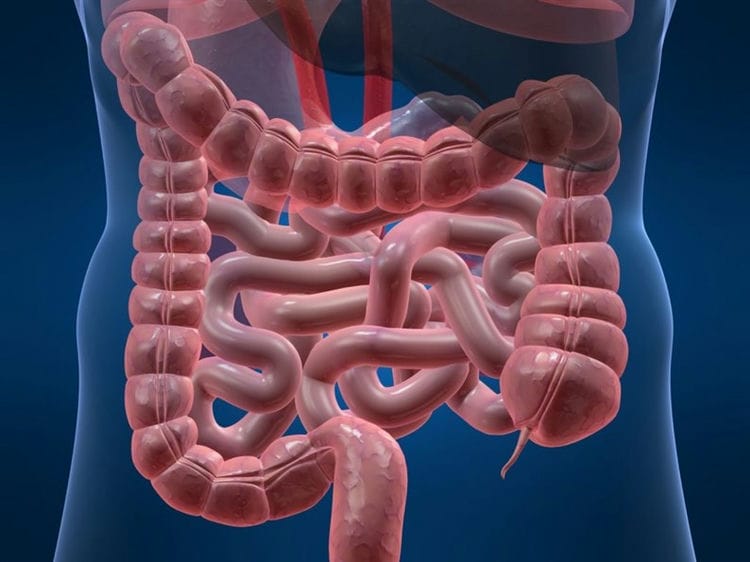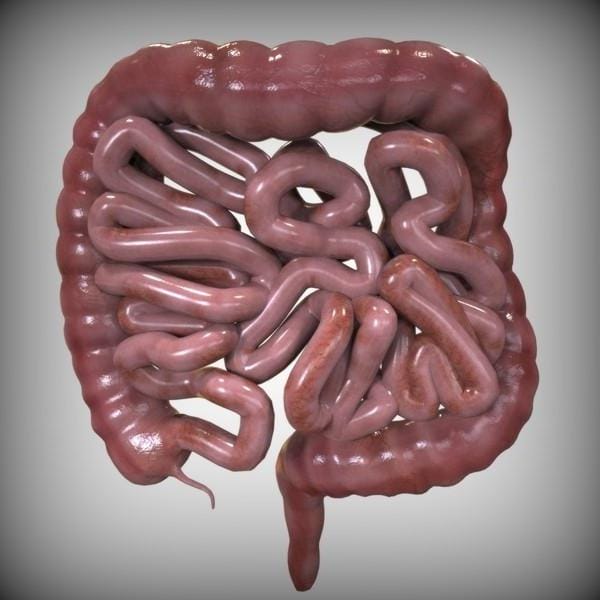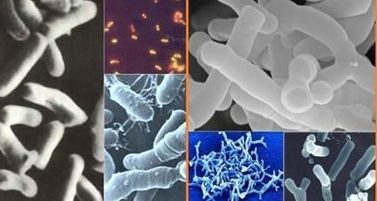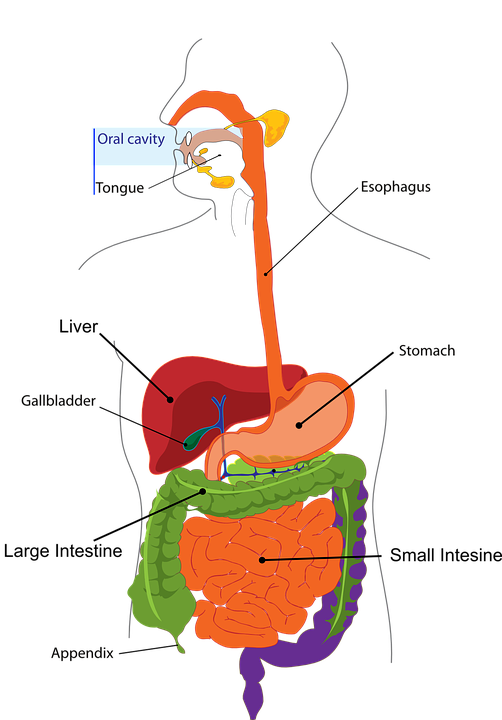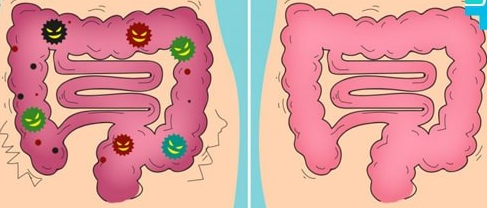How does the human intestine work? The structure and function of the intestine. Human intestine: structure, function
What is the intestine, anatomy
The intestines are one of the most important human organs.
The intestine is the human digestive and excretory organ. The volumetric image clearly demonstrates the structure diagram: what the human intestine consists of and how it looks.
It is located in the abdominal space and consists of two segments: thin and thick.
There are two sources of its blood supply:
- Thin – we supply blood from the superior mesenteric artery and celiac trunk
- Thick – from the superior and inferior mesenteric artery.
The starting point of the intestinal structure is the pylorus of the stomach, and it ends with the anus.
Being in constant activity, the length of the intestine in a living person is about four meters; after death, the muscles relax and provoke its increase in size up to eight meters.
The intestine grows with the human body, changing its size, diameter, thickness.
So in a newborn child, its length is about three meters, and the period of intensive growth is the age from five months to five years, when the child moves from breastfeeding to a common “table” and increased portions.
The intestine performs the following functions in the human body:
- Provides the intake of hydrochloric acid in the stomach for the primary processing of food;
- Actively participates in the digestive process, splitting the eaten foods into separate components and taking from them the trace elements necessary for the body, water;
- Forms and removes feces from the body;
- It has an important effect on the hormonal and immune systems of a person;
Intestine structure
Being one whole organ, the intestine consists of several sections, passing into each other, these are:
- duodenum;
- small intestine;
- colon;
- rectum.
The human intestine, the photo of which is presented above, has a complex anatomical structure. All the main departments are clearly visible here.
In more detail, the anatomy of the human intestine is represented by smaller sections:
- duodenum;
- jejunum and ileum;
- cecum;
- ascending transverse and descending colon;
- sigmoid and rectum;
- anus.
The human intestine begins immediately after the stomach and joins it. And it ends with the anal opening – the anus. As an integral part of the digestive tract, the intestines closely interact with all the organs that make up it. It is in the intestines that bile comes from the gallbladder, while it itself supplies the stomach with hydrochloric acid for the primary decomposition of the food supplied. Having a complex, varied structure and purpose, it plays one of the most important functions in human life.
Thus, the total length of the intestine in an adult is about 7-9 meters, while in a newborn, its length is 3.5 meters. Since it grows with the person, its location can change depending on age. The diameter and shape of the intestines also change, increasing and expanding with age.
Human intestinal functions
The intestine is part of the digestive system, and is part of the human immune system. Such important processes as take place in it:
- digestion of food;
- the allocation of trace elements and water from food;
- synthesis of hormones;
- the formation of immunity occurs;
- toxins and hazardous compounds are eliminated.
Our assistants
The human gut contains about fifty trillion bacteria. This is more than the total number of cells in our body.
Microorganisms mutually coexist with us, help to digest food, fight against disturbers of the digestive flora. They are divided into two main types: anaerobes and aerobes.
Anaerobes are bacteria that extract energy without oxygen. There are also macroscopic organisms belonging to this group.
Aerobes are organisms that require free-form oxygen to generate energy. The basis of life is oxidative processes with the participation of molecular oxygen.
Californian studies have shown that the bacteria in our gut are inversely related to our eating habits and vice versa, and even affect the micron-level nerve endings, sending signals to our brains. The inhabitants of the coast will find microorganisms used to sea food, which cannot be found among the inhabitants of continental latitudes.
How does the human intestine work?
Just like the esophagus and stomach, the intestines work by peristaltic contractions, pushing the contents towards its end, that is, the anus. During this movement, the chyme is processed by intestinal juices and broken down to amino acids and other simple compounds. In this state, they can be absorbed into the intestinal wall and enter the bloodstream, through which nutrients and energy are carried throughout the body. The intestinal walls are made up of four layers:
- serous outer lining of the intestines;
- muscle layer;
- submucosa;
- intestinal mucosa.
These layers are conductors of valuable nutrients for the body, and also play the role of an energy exchanger. The intestine is the largest organ in the human body. Just like the lungs supply the body with oxygen from the outside world, the human intestine serves as a conductor between blood and energy consumed. The photo below shows that the blood supply to this organ is carried out through the three main branches of the abdominal part of the aorta.
Peristalsis is very diverse, contractions can be rhythmic, pendulum, figurative peristaltic and antiperistaltic, tactical. Such movements of the intestinal muscles allow not only to move the masses to the exit, but also to mix, rub and compact them together.
Splitting food
These are the most important components that the human digestive system has. Their functions are appropriate. The stomach is an enlarged part of the canal. It contains glands that produce gastric juice. They contribute to the rapid breakdown of food. This is the main function of the stomach – to digest food. But this is not all the organs that the human digestive system includes.
The liver also helps to break down food. And also the pancreas. It is the liver that produces bile, which helps in the digestion of food. And the pancreas secretes special enzymes that also “help” bile by helping to break down carbohydrates, fats and proteins.
Digestion and absorption of nutrients
Chemical changes in food components mainly occur in the lumen of the small intestine. The same processes take place inside the cells of the epithelium and near the villi. Numerous glands of the small intestine in the mucous layer secrete up to 2 liters of digestive juice with enzymes that decompose food into its constituent parts per day. Proteins and peptides are broken down into amino acids. Fats break down into fatty acids and glycerin. The main digestion product of complex carbohydrates is glucose.
The function of the small intestine is not only to break down food. Another important process takes place – the absorption of end products into the blood and lymphatic capillaries in the villi. Water, nutrients, vitamins and mineral components pass from the intestinal lumen to the blood and lymph, and can participate in metabolism. From them, as from the parts of the constructor, the body creates its own proteins, fats and carbohydrates.
Intestinal absorption is a complex chemical and physiological phenomenon. Amino acids and glucose directly enter the blood of the intestinal villi capillaries. Fats are absorbed into the lymphatic capillaries, then enter the bloodstream. There is not only diffusion of molecules through the mucous membrane. Some particles are actively transported from the intestine due to the coordinated work of ions.
Important! Intestinal malabsorption is a serious problem for the entire body. Metabolism worsens, there is a deficiency of vitamins, trace elements, iron.
The intestine is usually called the “second brain” of the human body. The upper sections produce hormonal substances that are necessary for the intestines itself and the entire body for normal functioning, the functioning of the immune system. Most of the cells that produce such compounds are located in the walls of the duodenum.
Intestinal wall structure
In its composition, the intestinal wall has 4 main layers, densely strewn with arteries. These are layers such as:
- The mucous membrane, which in turn has an epithelial layer, Lyuberkunovy glands (crypts) and a muscle plate.
- The submucosa, which is formed from connective tissue, blood vessels, nerves. There is Meissner’s nerve plexus, collagen and reticular connective fibers.
- The muscular membrane, between the layers of which the Auerbach nerve plexus is located.
- The serous layer, which has connective tissue, and on top is a layer of dense epithelium.
Small intestine
The small intestine is a section that is bounded by the pylorus of the stomach (in the initial part) and the cecum with the appendix (in the final part). It digests food by digestive enzymes and absorbs most of the nutrients. There are several divisions in the structure of the small intestine:
- duodenum;
- jejunum;
- ileum.
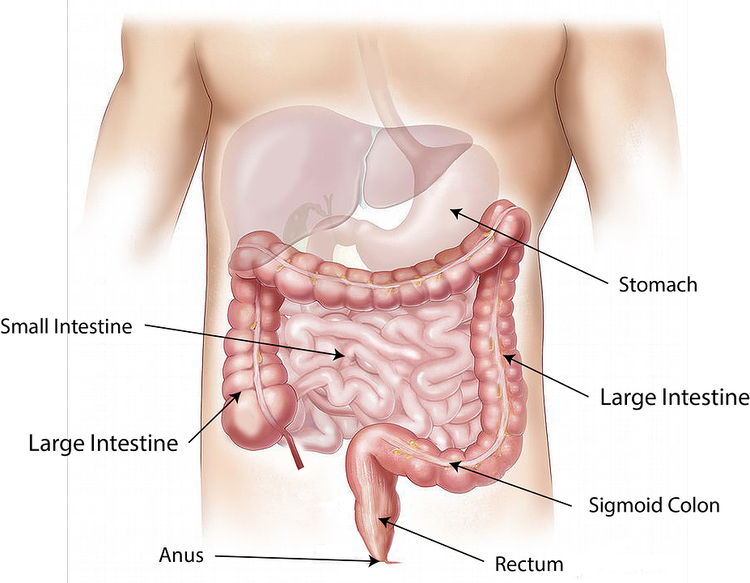
Duodenum
The duodenum is the beginning of the small intestine. Food enters it from the pylorus of the stomach. The cells of the mucous membrane of the organ secrete a large amount of mucous secretion, thereby providing an alkaline environment for the contents of the organ. The secretion is necessary in order to neutralize the acidic environment of food coming from the stomach.
The pancreatic duct opens into the lumen of the duodenum. Its juice contains digestive enzymes that help digest food. These include:
- intestinal amylase;
- lipase;
- chymotrypsin and trypsin.
Enzymes break down proteins, fats and carbohydrates into fragments that can pass through the intestinal wall and enter the bloodstream.
Bile is also involved in digestion – a secret that is produced by the liver and gallbladder. Bile emulsifies fats: it separates them into small droplets, due to which the process of enzymes is accelerated.
After digestion, fragments of molecules formed after exposure to enzymes are absorbed by intestinal cells and transported into the blood. These can be amino acids (constituents of proteins), glucose, fat fragments. The absorption process begins in the duodenum and continues throughout the small intestine.
…
Jejunum
The jejunum is the middle part of the small intestine, which is intermediate between the duodenum and the ileum. The jejunum is located in the left hypochondrium (above, under the costal arch). The length of the department is approximately 1-2 meters.
In the jejunum, the process of digestion and absorption of substances from food continues. Biochemical reactions occur on the surface of the cells of the intestinal epithelium mucosa (parietal digestion). The products are first broken down into fragments, and then pass through the mucous membrane and enter the bloodstream. Most of the nutrients are absorbed from the beginning of the jejunum.
Ileum
The ileum is the terminal portion of the small intestine that passes into the large intestine to form the ileocecal angle. The organ is located in the iliac region – in the lower abdomen on the right. Anatomically, it is difficult to find the place where the jejunum passes into the ileum, but these divisions have a number of differences. The ileum has a larger lumen diameter and a thicker wall. In relation to the midline, the iliac part lies on the right, and the skinny part on the left.
The process of absorption of nutrients continues in the ileum. Here vitamins, minerals, bile acids are assimilated. The assimilation of digestive products occurs through active transport – the transfer of molecules through the membranes of mucosal cells with the expenditure of energy.
Large intestine and its divisions
Unlike the small intestine, in which all nutrients are absorbed from the food digested by the stomach, the large intestine in the human body is engaged in the absorption of water and the formation of feces. It is represented by:
• the cecum;
• colon;
• rectum.
Each of the departments has its own constituent parts.
The cecum is a kind of appendage located where the small intestine “turns” into the large intestine. Undigested food residues are “dumped” into this temporary storage area, from where they then move to other parts of the large intestine. Unloved by many for its property to become inflamed at the wrong time, the appendix is an appendage of the cecum, scientifically called the appendix. With an average length of only 7-10 cm, the appendix is present only in humans and some species of mammals.
The colon is a section that is a continuation of the cecum. In fact, it is the colon, which includes such parts as the ascending colon, transverse colon, descending colon and sigmoid colon, that is the main part of the colon. This part of the intestine no longer takes part directly in digestion. What remains of food during the processing stage in the small intestine gets here in a relatively liquid form. Residual water and electrolytes are absorbed. The remaining material is converted into feces.
The rectum is the end of the intestine and the entire human digestive tract. It does not have pronounced bends compared to other segments of the human intestine and continues to the very anus. Its upper part is called the ampulla of the rectum, the lower part is called the anal canal. In the rectum, the processes of fecal formation are completed.
Cecum
The cecum is the initial section of the large intestine, which is saccular in shape. Its length ranges from 3-4 to 78 centimeters. This department received this name due to the fact that one of its poles ends blindly. Here, a process – the appendix – departs from the organ. It is a long and narrow section of the intestine that has a cavity inside. The position of the appendix may differ depending on the individual characteristics of the person.
Above the place of origin of the appendicular process is the ileocecal angle – the place where the ileum flows into the blind. In this area, the contents of the organ pass from the small intestine to the large intestine.
Colon
The colon is the main part of the large intestine, which is U-shaped. Depending on the position, several main parts of the colon are distinguished:
- Ascending part.
- Transverse part.
- Descending part.
- Sigmoid part.
The ascending part begins in the lower abdomen on the right (right iliac region), rises vertically upward and forms the hepatic bend in the right hypochondrium. From it begins the transverse part of the organ, which runs horizontally. It passes into the descending part with the formation of the splenic flexure in the left hypochondrium. In the lower part of the abdomen on the left (left iliac region) is the last section of the colon – the sigmoid. It forms a bend that passes into the end of the large intestine, the rectum.
Rectum
The rectum is a fragment of the large intestine, delimited by the sigmoid colon and the anus. The length of the organ is approximately 15-16 centimeters. In the middle part, the rectum forms an ampulla – an area in which feces accumulate. At the end, the direction of the intestine shifts down and back – an anal canal is formed, which ends with the anus.
Common bowel disorders
The human intestine is a unique organ. Despite the fact that its functional component is strong, it is not difficult to cause disturbances in the work of the intestines. Many people have the wrong impression about this organ as a system for processing any garbage: whatever you send to it, it will process everything and remove it outside the body. This is partly true, but the rich microflora is easily destroyed, leading to various disorders in the intestines.
When this most important part of the digestive system fails, symptoms such as problems with stools, pain in the lower abdomen, and false urge to empty (tenesmus) appear. Symptoms of bowel dysfunction can even include headaches, excessive sweating, weakness, malaise, and breathing problems. Very often skin diseases speak of improper bowel function. The clearest example is acne, indicating a slagging of the intestines.
Below is a list of common symptoms and associated bowel problems. Of course, any of the described symptoms only roughly indicates a specific disorder. A more accurate reason can be found out only after passing an examination under the supervision of a doctor. It’s not worth joking with the intestines: even banal constipation can be the result of very serious problems that require urgent medical intervention.
Constipation is a symptom of poor nutrition, often deprived of the necessary amount of plant foods (fiber). In addition, a sedentary lifestyle common today can become the cause of constipation. Constipation can signal the presence of intestinal adhesions, or tumors of the uterus or appendages in women. By the way, constipation often occurs during menopause, and the reasons can be psychological. Neurogenic constipation is common. Someone cannot go to the toilet during a train ride, someone finds it difficult to do this in uncomfortable conditions of temporary residence (camp, sanatorium). It should be noted that stool 3 times a day up to 3 times a week is the norm if a person does not experience physical and emotional discomfort. Stool retention in combination with flatulence may indicate gynecological peritonitis.
Tenesmus is an unpleasant condition presenting a false urge to defecate, usually painful, with very little or no stool. It may accompany dysentery or cholera, although in some cases it appears after radiotherapy and radiotherapy of the genitals.
Diarrhea is a frequent and liquid stupor, the causes of which can be intestinal infections, but sometimes diarrhea can indicate much more dangerous problems, such as intestinal tuberculosis or parametritis.
Various types of pain: pain during bowel movements is a signal of the presence of hemorrhoids or paraproctitis. In women, such pain can occur with inflammation in the peri-uterine and perivaginal tissue. If the pain does not stop the rest of the time, this may indicate cancer of the rectum or genitals. In women, pain that spreads to the rectum may indicate an ectopic pregnancy.
An appetite disorder or its complete disappearance is a symptom of an exacerbation of chronic intestinal diseases.
Systematic disturbances in the work of the intestines are a reason to immediately visit a general practitioner, who, on the basis of an initial examination, sends the patient to a gastroenterologist, proctologist or nutritionist, depending on the type of problem detected.
The reasons
There is a large list of diseases inherent in the human intestine and six main ways of their occurrence:
1 Infections
2 Parasites
3 Wrong lifestyle
4 Genetic factors
5 Taking medications
6 Immunity malfunctions
And if banal precautions and hygiene rules protect from the first two points in most cases, no one is immune from the third.
An improper lifestyle means the presence of bad habits (smoking), low mobility, stress, unhealthy diet. Of course, you can quit smoking or not start at all, it is not difficult to force yourself to eat right. Avoiding a sedentary job or constant nervousness is more difficult. According to some reports, people who work while sitting for many years are at an increased risk of bowel cancer.
The fourth item on the list is genetic predisposition. For example, this cause, along with immune deficiency, is often cited for ulcerative colitis, a common condition that manifests itself as inflammation of the intestinal mucosa. Long-term medication (5th point), namely antibiotics, is capable of destroying the intestinal microflora. As a result of the death of a large number of, for example, bifidobacteria, dysbiosis develops.
The last point is interconnected with the first two: when the immune defense is weakened, foreign bacteria and parasites are more easily absorbed in the human intestine.
Diseases of the human intestine
The list of diseases affecting the human intestine is long. The most common infectious diseases:
• dysentery;
• amebiasis;
• cholera;
• typhoid fever.
They are all caused by different types of bacteria and amoebas. You can get infected with any of the listed diseases without washing your hands before eating. It would seem that an intestinal infection, at best, turns into many hours of agony, accompanied by diarrhea and vomiting, but what is the worst? The statistics are as follows: over the course of a year, tens of millions of people fall ill with various types of dysentery, and from 1% to 9% die.
Of course, deaths are due to the lack of qualified medical care, which is characteristic of poor countries. For example, more than 9.5 thousand people died from cholera in 2015 in Haiti, which is a decent share of the country’s population. There are frequent epidemics of intestinal infections in the world.
There are also more dangerous infectious diseases:
• intestinal tuberculosis, the source of which is mycobacterium tuberculosis;
• intestinal syphilis – a rare form of sexually transmitted disease.
Diseases of the intestines of a parasitic nature are:
• ascariasis;
• trichinosis;
• intestinal myiasis;
• hookworm infection;
• trichocephalosis;
• scarabiasis;
other. What these diseases have in common is that they represent intestinal damage by various types of parasites. For example, a very unpleasant disease, which, according to various estimates, affects 800 million to 1.2 billion people, is ascariasis. The majority of carriers of the roundworm parasite live in poor developing countries. The size of an adult worm can reach 30 centimeters. It parasitizes in the small intestine, and the eggs of the parasite enter the body through unwashed fruits and vegetables.
The symptoms of ascariasis are complex enough to diagnose the presence of a parasite in the body by some of the symptoms. A full medical examination is required, including blood and feces tests. Symptoms include a slight increase in body temperature for a long time, allergic reactions, abdominal pain, nausea, itching in the anus. Some of the parasitic bowel diseases are not caused by worms. For example, the source of intestinal myiasis is the larvae of flies, including the most common indoor flies, and the scarabiasis is actually the beetles that penetrate into the anus while a person sleeps. Fortunately, this disease is found only in the Southern Hemisphere, but avid travelers should know about it.
Parameters and diseases of the intestine
| Intestine and its departments | Parameters (cm) | Diseases |
|---|---|---|
| Length | Diameter | |
| Small intestine | 350-400 | Proximal 4-6, distal 2-3. |
| Duodenal | 21-25 | 42859 |
| Skinny | 90-180 | |
| Iliac | 130-260 | 2.7 |
| Colon | 150-200 | 42951 |
| Blind | 3-8.5 | 7 |
| Colonic | About 150 | 5 -8 |
| Straight | 14-18 | 4-7.5 |
The general state of human health depends on the normal functioning of the intestines. This organ is susceptible to various disorders, disorders and inflammations, often due to the fault of a person with errors in nutrition. Serious pathologies are also no exception – to prevent their development and exacerbation, it is recommended to monitor your health, undergo unscheduled examinations, and lead a healthy lifestyle.
We keep it normal
The health of the body directly depends on the maintenance of the intestines at the proper level. The products we eat are directly proportional to the decent functioning of this important organ.
Environmental pollution, poisoning of alcohol and tobacco products, the abuse of antibiotics, the use of antibacterial agents, the use of large amounts of sugar and carbohydrates cause a negative shift in the normal function of the intestines. Stress can also be a cause of the disorder.
Adjusting nutrition will help normalize the microflora. Fruits and vegetables rich in fiber and pectin, whole grains, dairy products – all these can help to cope with a number of disorders.
Food should be varied and include both proteins and fats of vegetable and animal origin. It is better to eat in small portions and drink more clean water. The length of the intestines of any person, includes the processing departments, in a clear sequence, of a technologically precise digestive plant.
Let’s summarize
Particular attention should be paid to the freshness of the food consumed. Disease-causing bacteria in the same huge quantities are in the external environment and our internal helpers will not cope with all of them.
It is very easy to get poisoned and the total length of the intestine, with all the protective functions, will not save. The stomach of some can and digests nails, but there are a number of bacteria and toxic substances of plant and man-made origin, which not only knock out of the rut for some time, but will cause serious diseases, cancers and can even lead to death. This will never happen if you are attentive to yourself and your loved ones.
Useful physical activity will not be superfluous, since with the work of muscles and ligaments, all metabolic processes are enhanced, mood improves and the craving for life increases, which we all sometimes lack.
Sources used and useful links on the topic: https://LechimZapor.com/kishechnik/stroenie https://www.syl.ru/article/183464/new_kak-rabotaet-kishechnik-cheloveka-stroenie-i-funktsii-kishechnika https: //GemoParazit.ru/raznoe/kishechnik-cheloveka https://bugmk.ru/zhkt-drugoe/tolstyj-kishechnik.html https://ProKishechnik.info/anatomiya/stroenie/kishechnik-stroenie-i-funkcii.html https: //lechimzhivot.ru/kishechnik/stroenie-funktsii-zabolevaniya.html

